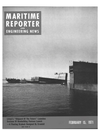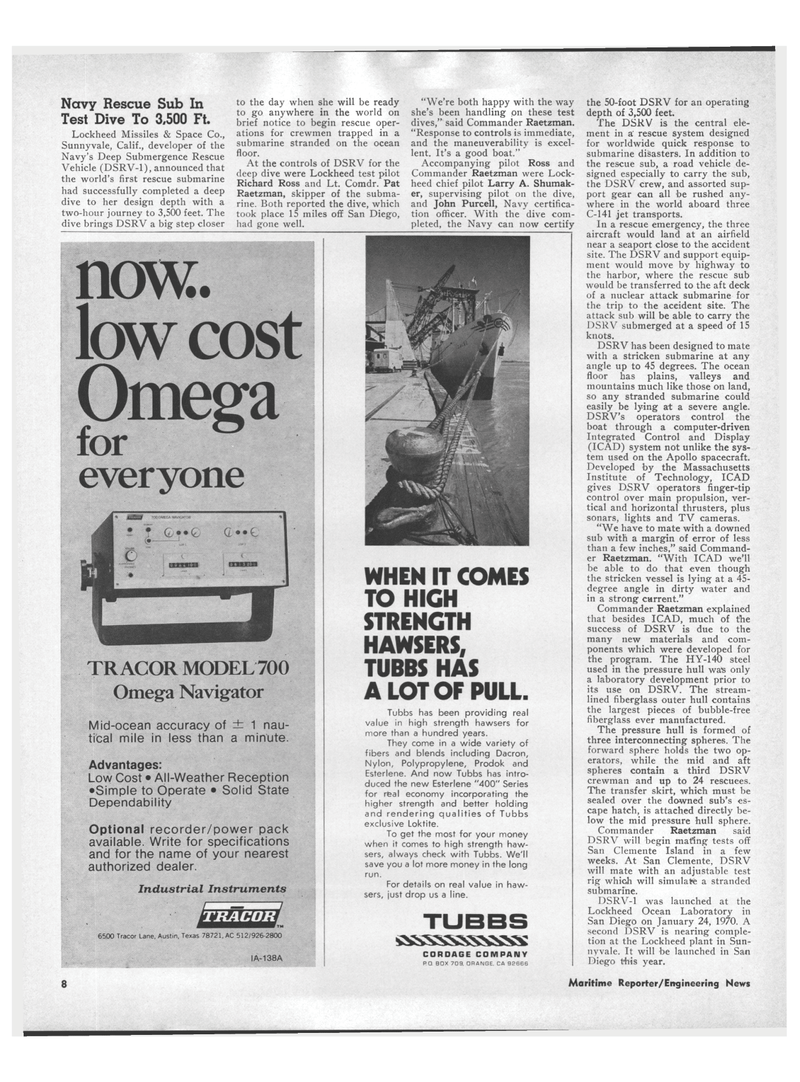
Page 6: of Maritime Reporter Magazine (February 15, 1971)
Read this page in Pdf, Flash or Html5 edition of February 15, 1971 Maritime Reporter Magazine
Navy Rescue Sub In
Test Dive To 3,500 Ft.
Lockheed Missiles & Space Co.,
Sunnyvale, Calif., developer of the
Navy's Deep Submergence Rescue
Vehicle (DSRV-1), announced that the world's first rescue submarine had successfully completed a deep dive to her design depth with a two-hour journey to 3,500 feet. The dive brings DSRV a big step closer to the day when she will be ready to go anywhere in the world on brief notice to begin rescue oper- ations for crewmen trapped in a submarine stranded on the ocean floor.
At the controls of DSRV for the deep dive were Lockheed test pilot
Richard Ross and Lt. Comdr. Pat
Raetzman, skipper of the subma- rine. Both reported the dive, which took place 15 miles off San Diego, had gone well. "We're both happy with the way she's been handling on these test dives," said Commander Raetzman. "Response to controls is immediate, and the maneuverability is excel- lent. It's a good boat."
Accompanying pilot Ross and
Commander Raetzman were Lock- heed chief pilot Larry A. Shumak- er, supervising pilot on the dive, and John Purcell, Navy certifica- tion officer. With the dive com- pleted, the Navy can now certify the 50-foot DSRV for an operating depth of 3,500 feet.
The DSRV is the central ele- ment in a rescue system designed for worldwide quick response to submarine disasters. In addition to the rescue sub, a road vehicle de- signed especially to carry the sub, the DSRV crew, and assorted sup- port gear can all be rushed any- where in the world aboard three
C-141 jet transports.
In a rescue emergency, the three aircraft would land at an airfield near a seaport close to the accident site. The DSRV and support equip- ment would move by highway to the harbor, where the rescue sub would be transferred to the aft deck of a nuclear attack submarine for the trip to the accident site. The attack sub will be able to carry the
DSRV submerged at a speed of 15 knots.
DSRV has been designed to mate with a stricken submarine at any angle up to 45 degrees. The ocean floor has plains, valleys and mountains much like those on land, so any stranded submarine could easily be lying at a severe angle.
DSRV's operators control the boat through a computer-driven
Integrated Control and Display (ICAD) system not unlike the sys- tem used on the Apollo spacecraft.
Developed by the Massachusetts
Institute of Technology, ICAD gives DSRV operators finger-tip control over main propulsion, ver- tical and horizontal thrusters, plus sonars, lights and TV cameras. "We have to mate with a downed sub with a margin of error of less than a few inches," said Command- er Raetzman. "With ICAD we'll be able to do that even though the stricken vessel is lying at a 45- degree angle in dirty water and in a strong current."
Commander Raetzman explained that besides ICAD, much of the success of DSRV is due to the many new materials and com- ponents which were developed for the program. The HY-140 steel used in the pressure hull was only a laboratory development prior to its use on DSRV. The stream- lined fiberglass outer hull contains the largest pieces of bubble-free fiberglass ever manufactured.
The pressure hull is formed of three interconnecting spheres. The forward sphere holds the two op- erators, while the mid and aft spheres contain a third DSRV crewman and up to 24 rescuees.
The transfer skirt, which must be sealed over the downed sub's es- cape hatch, is attached directly be- low the mid pressure hull sphere.
Commander Raetzman said
DSRV will begin mafing tests off
San Clemente Island in a few weeks. At San Clemente, DSRV will mate with an adjustable test rig which will simulate a stranded submarine.
DSRV-1 was launched at the
Lockheed Ocean Laboratory in
San Diego on January 24, 1970. A second DSRV is nearing comple- tion at the Lockheed plant in Sun- nyvale. It will be launched in San
Diego this year. now. low cost
Omega for everyone .j^Mf ?00 OMEGA NAVIGATOR • T (• J c ~ **
TR ACOR MODEL 700
Omega Navigator
Mid-ocean accuracy of ± 1 nau- tical mile in less than a minute.
Advantages:
Low Cost • All-Weather Reception •Simple to Operate • Solid State
Dependability
Optional recorder/power pack available. Write for specifications and for the name of your nearest authorized dealer.
Industrial Instruments 6500 Tracor Lane. Austin, Texas 78721, AC 512/926-2800
IA-138A
WHEN IT COMES
TO HIGH
STRENGTH
HAWSERS,
TUBBS HAS
A LOT OF PULL.
Tubbs has been providing real value in high strength hawsers for more than a hundred years.
They come in a wide variety of fibers and blends including Dacron,
Nylon, Polypropylene, Prodok and
Esterlene. And now Tubbs has intro- duced the new Esterlene "400" Series for real economy incorporating the higher strength and better holding and rendering qualities of Tubbs exclusive Loktite.
To get the most for your money when it comes to high strength haw- sers, always check with Tubbs. We'll save you a lot more money in the long run.
For details on real value in haw- sers, just drop us a line.
CORDAGE COMPANY
PQ BOX 709, ORANGE. Cfl 92666 8 Maritime Reporter/Engineering News

 5
5

 7
7
